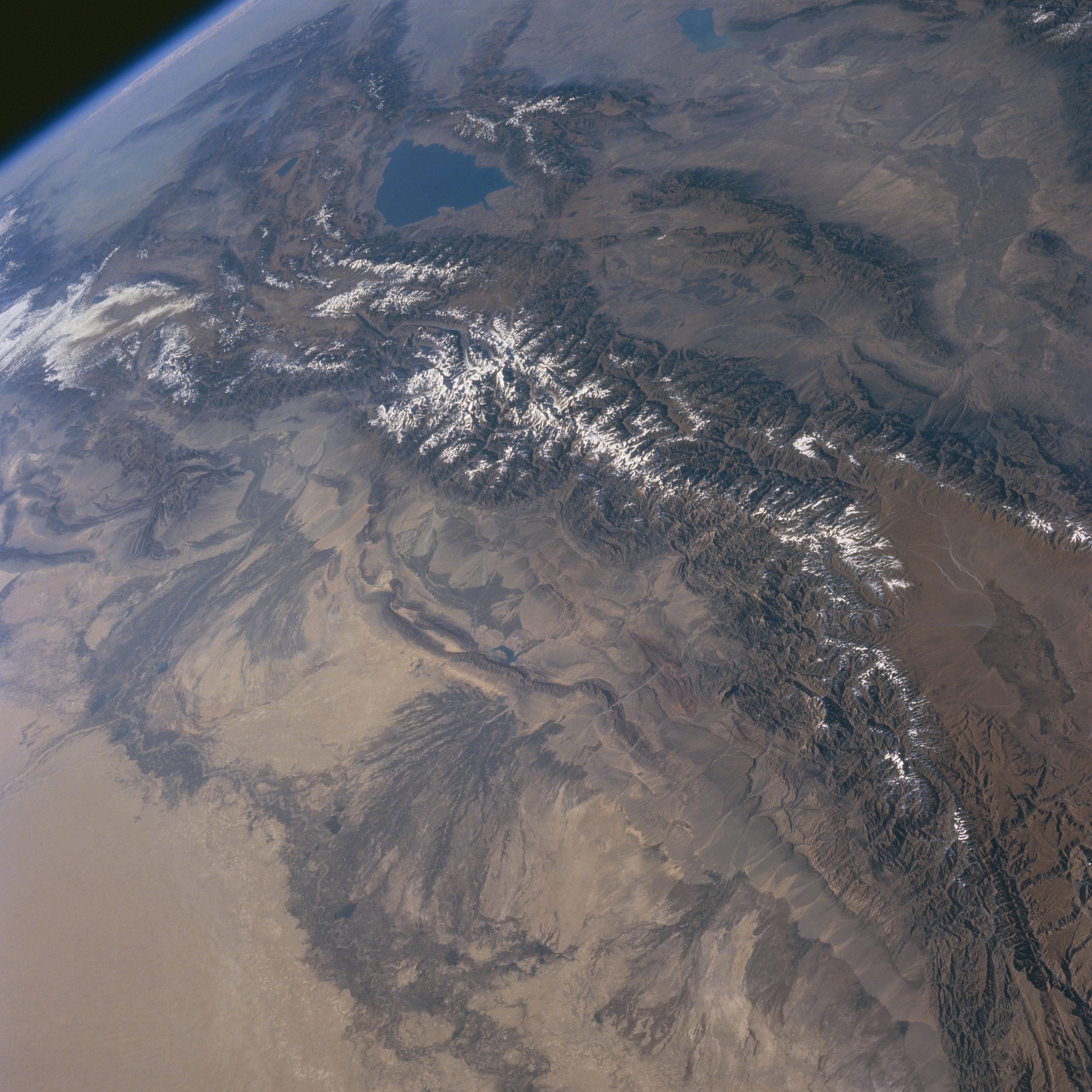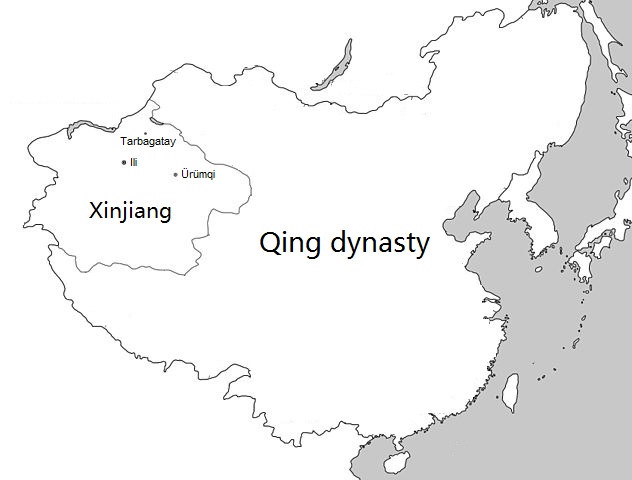|
Nanshan (Kazakhstan)
__NOTOC__ The Wusun Mountains or Ketmen Mountains are a small range in the central part of the Tianshan Mountains. They lie north of the Tekes River valley and south of the main Ili River valley in southeastern Kazakhstan and in western Xinjiang Province, China. The highest point is Baishi Peak (), about above sea level. Names is the pinyin form of the Chinese language, Chinese name written in traditional characters and in simplified ones, taken from the ancient Wusun people. It is sometimes distinguished as particularly the Chinese part of the range, the Kazakh area being the Ketmen Ridge. The mountains have also been known as the (russian: Каратау), (, "Black Mountain"), ( kk, Темирлик, "Iron-Bearing" or "Producing"), and (, "South" or "Southern Mountains").. See also * Tianshan Mountains References Citations Bibliography * . * . {{coord, 43.347454, N, 80.695134, E, display=title, format=dms Mountain ranges of Xinjiang Mountain ranges of Kaz ... [...More Info...] [...Related Items...] OR: [Wikipedia] [Google] [Baidu] |
Tianshan
The Tian Shan,, , otk, 𐰴𐰣 𐱅𐰭𐰼𐰃, , tr, Tanrı Dağı, mn, Тэнгэр уул, , ug, تەڭرىتاغ, , , kk, Тәңіртауы / Алатау, , , ky, Теңир-Тоо / Ала-Тоо, , , uz, Tyan-Shan / Tangritog‘, , also known as the Tengri Tagh or Tengir-Too, meaning the ''Mountains of Heaven'' or the ''Heavenly Mountain'', is a large system of mountain ranges located in Central Asia. The highest peak in the Tian Shan is Jengish Chokusu, at high. Its lowest point is the Turpan Depression, which is below sea level. One of the earliest historical references to these mountains may be related to the Xiongnu word ''Qilian'' ( zh, s=祁连, t=祁連, first=t, p=Qílián) – according to Tang commentator Yan Shigu, ''Qilian'' is the Xiongnu word for sky or heaven. Sima Qian in the ''Records of the Grand Historian'' mentioned ''Qilian'' in relation to the homeland of the Yuezhi and the term is believed to refer to the Tian Shan rather than the Qi ... [...More Info...] [...Related Items...] OR: [Wikipedia] [Google] [Baidu] |
Pinyin
Hanyu Pinyin (), often shortened to just pinyin, is the official romanization system for Standard Mandarin Chinese in China, and to some extent, in Singapore and Malaysia. It is often used to teach Mandarin, normally written in Chinese form, to learners already familiar with the Latin alphabet. The system includes four diacritics denoting tones, but pinyin without tone marks is used to spell Chinese names and words in languages written in the Latin script, and is also used in certain computer input methods to enter Chinese characters. The word ' () literally means " Han language" (i.e. Chinese language), while ' () means "spelled sounds". The pinyin system was developed in the 1950s by a group of Chinese linguists including Zhou Youguang and was based on earlier forms of romanizations of Chinese. It was published by the Chinese Government in 1958 and revised several times. The International Organization for Standardization (ISO) adopted pinyin as an international st ... [...More Info...] [...Related Items...] OR: [Wikipedia] [Google] [Baidu] |
Mountain Ranges Of Xinjiang
A mountain is an elevated portion of the Earth's crust, generally with steep sides that show significant exposed bedrock. Although definitions vary, a mountain may differ from a plateau in having a limited summit area, and is usually higher than a hill, typically rising at least 300 metres (1,000 feet) above the surrounding land. A few mountains are isolated summits, but most occur in mountain ranges. Mountains are formed through tectonic forces, erosion, or volcanism, which act on time scales of up to tens of millions of years. Once mountain building ceases, mountains are slowly leveled through the action of weathering, through slumping and other forms of mass wasting, as well as through erosion by rivers and glaciers. High elevations on mountains produce colder climates than at sea level at similar latitude. These colder climates strongly affect the ecosystems of mountains: different elevations have different plants and animals. Because of the less hospitable terrain and ... [...More Info...] [...Related Items...] OR: [Wikipedia] [Google] [Baidu] |
Ketmen Ridge
The Ketmen Ridge is a mountain range located in southern Kazakhstan, close to the borders of China and Kyrgyzstan. The ridge is within the territory of the China and Raiymbek districts of the Almaty region. It is located to the east of the Zailiisky Alatau, in the northern Tien Shan mountain range. The total length of the ridge is and its width is up to . The Ketmen Ridge runs from the Kyungei-Ala-Too Ridge in the west to the Narat Ridge in the east and its northern slopes pass into the Ili Valley. It forms the southern border of the ‘ Semirechiya’ (‘Seven Rivers’) region, which surrounds Almaty. The altitude ranges from 3,000 to 3,600 m, with the highest point being Mount Aspan at . The ridge is composed of igneous and sedimentary rocks such as granite and limestone. The slopes are steep with gentle peaks below the snow line. The ridge has a permafrost zone but does not have glaciation or snowfields. It contains steppe and taiga forests which consist mainly of ... [...More Info...] [...Related Items...] OR: [Wikipedia] [Google] [Baidu] |
Traditional Characters
Traditional Chinese characters are one type of standard Chinese character sets of the contemporary written Chinese. The traditional characters had taken shapes since the clerical change and mostly remained in the same structure they took at the introduction of the regular script in the 2nd century. Over the following centuries, traditional characters were regarded as the standard form of printed Chinese characters or literary Chinese throughout the Sinosphere until the middle of the 20th century, before different script reforms initiated by countries using Chinese characters as a writing system. Traditional Chinese characters remain in common use in Taiwan, Hong Kong and Macau, as well as in most overseas Chinese communities outside Southeast Asia; in addition, Hanja in Korean language remains virtually identical to traditional characters, which is still used to a certain extent in South Korea, despite differing standards used among these countries over some variant Ch ... [...More Info...] [...Related Items...] OR: [Wikipedia] [Google] [Baidu] |
Chinese Language
Chinese (, especially when referring to written Chinese) is a group of languages spoken natively by the ethnic Han Chinese majority and many minority ethnic groups in Greater China. About 1.3 billion people (or approximately 16% of the world's population) speak a variety of Chinese as their first language. Chinese languages form the Sinitic branch of the Sino-Tibetan languages family. The spoken varieties of Chinese are usually considered by native speakers to be variants of a single language. However, their lack of mutual intelligibility means they are sometimes considered separate languages in a family. Investigation of the historical relationships among the varieties of Chinese is ongoing. Currently, most classifications posit 7 to 13 main regional groups based on phonetic developments from Middle Chinese, of which the most spoken by far is Mandarin (with about 800 million speakers, or 66%), followed by Min (75 million, e.g. Southern Min), Wu (74 million, e ... [...More Info...] [...Related Items...] OR: [Wikipedia] [Google] [Baidu] |
China
China, officially the People's Republic of China (PRC), is a country in East Asia. It is the world's List of countries and dependencies by population, most populous country, with a Population of China, population exceeding 1.4 billion, slightly ahead of India. China spans the equivalent of five time zones and Borders of China, borders fourteen countries by land, the List of countries and territories by land borders, most of any country in the world, tied with Russia. Covering an area of approximately , it is the world's third List of countries and dependencies by area, largest country by total land area. The country consists of 22 provinces of China, provinces, five autonomous regions of China, autonomous regions, four direct-administered municipalities of China, municipalities, and two special administrative regions of China, Special Administrative Regions (Hong Kong and Macau). The national capital is Beijing, and the List of cities in China by population, most populous cit ... [...More Info...] [...Related Items...] OR: [Wikipedia] [Google] [Baidu] |
Tekes River
Tekes may refer to: * Tekes (agency), the Finnish Funding Agency for Technology and Innovation * Tekes River in Kazakhstan and China, a tributary of the Ili River * Tekes County in Xinjiang, China, on the eponymous river * Tekes Town, the county seat of Tekes County See also * Tékes, a village in Hungary * Teke people, a Bantu-speaking ethnic group in Equatorial Africa * Tekezé River in Ethiopia * Teke (other) Teke or Tekke can refer to: People * Teke (Turkmen tribe) or Tekke, a tribe of southern Turkmenistan * Teke people or Bateke, a Central African ethnic group * Fatih Tekke (born 1977), Turkish footballer * Kent Tekulve (born 1947), American base ... * Tex (other) {{Disambiguation, geo ... [...More Info...] [...Related Items...] OR: [Wikipedia] [Google] [Baidu] |
Xinjiang Province
Xinjiang Province is a historical administrative area of Northwest China, between 1884 and 1955. Periods during which various boundaries of Xinjiang Province have been defined include: * Xinjiang Province (Qing) (1884–1912). * Xinjiang Province (Republic of China) (1912–1992) The actual control of the region by Republic of China was interrupted between 1933 and 1946 and ended entirely in 1949, but after the Central Government of the Republic of China moved to Taiwan, the government of Xinjiang Province (Republic of China) were abolished in 1992. * Xinjiang Autonomous Province (Republic of China) (1933–1944) a semi-independent local government established by Sheng Shicai (盛世才, Pinyin: Shèng Shìcái) in Xinjiang Province, Republic of China. * Xinjiang Province (People's Republic of China) (1949–1955) was replaced in 1955 by the newly established Xinjiang Uyghur Autonomous Region Xinjiang, SASM/GNC: ''Xinjang''; zh, c=, p=Xīnjiāng; formerly romanized as ... [...More Info...] [...Related Items...] OR: [Wikipedia] [Google] [Baidu] |
Kazakhstan
Kazakhstan, officially the Republic of Kazakhstan, is a transcontinental country located mainly in Central Asia and partly in Eastern Europe. It borders Russia Russia (, , ), or the Russian Federation, is a transcontinental country spanning Eastern Europe and Northern Asia. It is the largest country in the world, with its internationally recognised territory covering , and encompassing one-eigh ... to Kazakhstan–Russia border, the north and west, China to China–Kazakhstan border, the east, Kyrgyzstan to Kazakhstan–Kyrgyzstan border, the southeast, Uzbekistan to Kazakhstan–Uzbekistan border, the south, and Turkmenistan to Kazakhstan–Turkmenistan border, the southwest, with a coastline along the Caspian Sea. Its capital is Astana, known as Nur-Sultan from 2019 to 2022. Almaty, Kazakhstan's largest city, was the country's capital until 1997. Kazakhstan is the world's largest landlocked country, the largest and northernmost Muslim world, Muslim-majority cou ... [...More Info...] [...Related Items...] OR: [Wikipedia] [Google] [Baidu] |





